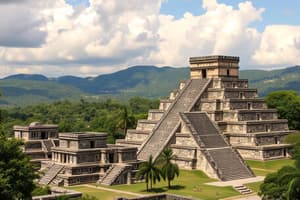Podcast
Questions and Answers
The embargo on Cuba was a result of U.S. alliance with the U.S.S.R.
The embargo on Cuba was a result of U.S. alliance with the U.S.S.R.
False (B)
During the Middle Ages, monks were only responsible for praying and meditating.
During the Middle Ages, monks were only responsible for praying and meditating.
False (B)
The Gothic style of art was mainly focused on religion.
The Gothic style of art was mainly focused on religion.
False (B)
The Hundred Years' War was fought between France and China.
The Hundred Years' War was fought between France and China.
The Black Death spread through Europe due to a virus transmitted by human contact.
The Black Death spread through Europe due to a virus transmitted by human contact.
The Crusades were a series of wars between European knights and the Ottoman Empire.
The Crusades were a series of wars between European knights and the Ottoman Empire.
The Spanish Social structure put people who migrated from Spain at the bottom of the social hierarchy, people who were born from Spanish immigrants in Mexico in the middle, and the natives at the top.
The Spanish Social structure put people who migrated from Spain at the bottom of the social hierarchy, people who were born from Spanish immigrants in Mexico in the middle, and the natives at the top.
The Florentine Codex is a book written by Hernan Cortez that tells the stories of Aztec Civilization.
The Florentine Codex is a book written by Hernan Cortez that tells the stories of Aztec Civilization.
Cuba and Puerto Rico are the last Caribbean Spanish colonies that still belong to Spain.
Cuba and Puerto Rico are the last Caribbean Spanish colonies that still belong to Spain.
The U.S. claimed war against Spain after a Spanish navy ship was destroyed.
The U.S. claimed war against Spain after a Spanish navy ship was destroyed.
Fidel Castro was a Cuban dictator against Mexico.
Fidel Castro was a Cuban dictator against Mexico.
The Mexican Cession was a treaty in which the U.S. gave ⅓ of its territory back to Mexico.
The Mexican Cession was a treaty in which the U.S. gave ⅓ of its territory back to Mexico.
Flashcards are hidden until you start studying
Study Notes
Spanish Colonization
- The conquistadors were Spanish soldiers who conquered land, stole gold, and converted natives to Christianity for Spain.
- Hernan Cortez destroyed the Aztec Civilization and murdered their leader, Monctezuma.
- The Spanish Social structure placed people from Spain at the top, those born in Mexico in the middle, and natives as slaves.
- The Spanish treated natives terribly.
- The Florentine Codex is a book that tells the stories of Spanish Colonization in Central America.
Mexican Revolt
- Weakened government, unfair social structure, and taxes were the causes of the Mexican Revolt.
Mexican Cession
- After Mexico became independent from Spain, there was a power struggle between leaders, resulting in Mexico losing ⅓ of its territory to the U.S.
Caribbeans
- Natives were hunter-gatherers who used canoes to get around.
- Columbus colonized the land, enslaving and killing natives.
- The Spanish targeted larger islands with more precious metals and larger farming space.
Cuba & Puerto Rico
- Last Caribbean Spanish colonies where citizens revolted against colonization and slavery for years.
- The U.S. claimed war against Spain after a U.S. navy ship was destroyed, and the U.S. won.
- Cuba gained independence but remained under U.S. control.
- Fidel Castro was a Cuban dictator against the U.S. who allied with the U.S.S.R., leading to a U.S. embargo on Cuba.
Economic Barriers in South America
- Poor citizens can't afford to buy products, causing economic decline.
- Poor individuals can't pay taxes used for infrastructure and improvements.
- Poor areas have a low percentage of educated individuals.
Medieval European History
Middle Ages Life
- Monasteries had scribes who copied manuscripts and made books.
- Monks taught reading and writing and took care of their community.
- Monks recorded history during the Middle Ages.
Daily Life
- Royals and nobles had banquets to show their power.
- Sumptuary laws determined nobles from peasants.
- Hunting was a favored sport of the nobles played on the Baron's land.
- Chess was introduced to Europe through Persia.
- Secular music was mainly about love during the Middle Ages.
Art & Literature
- Muslim artists made decorated tiles and rugs by hand.
- The Notre Dame is a Gothic cathedral in France.
- Byzantine and Romanesque art mainly focused on religion.
- Gothic art was more realistic and brighter.
- Illuminated manuscripts are illustrated manuscripts.
- Most books were written in Latin before the invention of the printing press.
Guilds
- Guilds provided work and craft to pass on to the next generation.
- Bookbinders and masons are two examples of craft guilds.
- Guilds had rules so all members have the same advantage.
Major Events
- The Hundred Years' War lasted 116 years.
- Edward the Black Prince was famous for his multiple victories for the British during the Hundred Years' War.
- Gunpowder reached Europe in 1300 from China.
- The longbow fired arrows farther than crossbows.
- The Black Death was a pandemic that spread over a wide area.
- Sailors had to quarantine for 40 days during the Black Plague.
- Fleas carried the Bubonic Plague.
- Lancing is when a doctor cuts into boils.
- Two symptoms are boils and fever.
- City officials tried to keep the plague from spreading by quarantining ships and shutting down restaurants.
- It started in Europe through rats and fleas.
- It took 300-400 years for population numbers to recover.
Studying That Suits You
Use AI to generate personalized quizzes and flashcards to suit your learning preferences.




